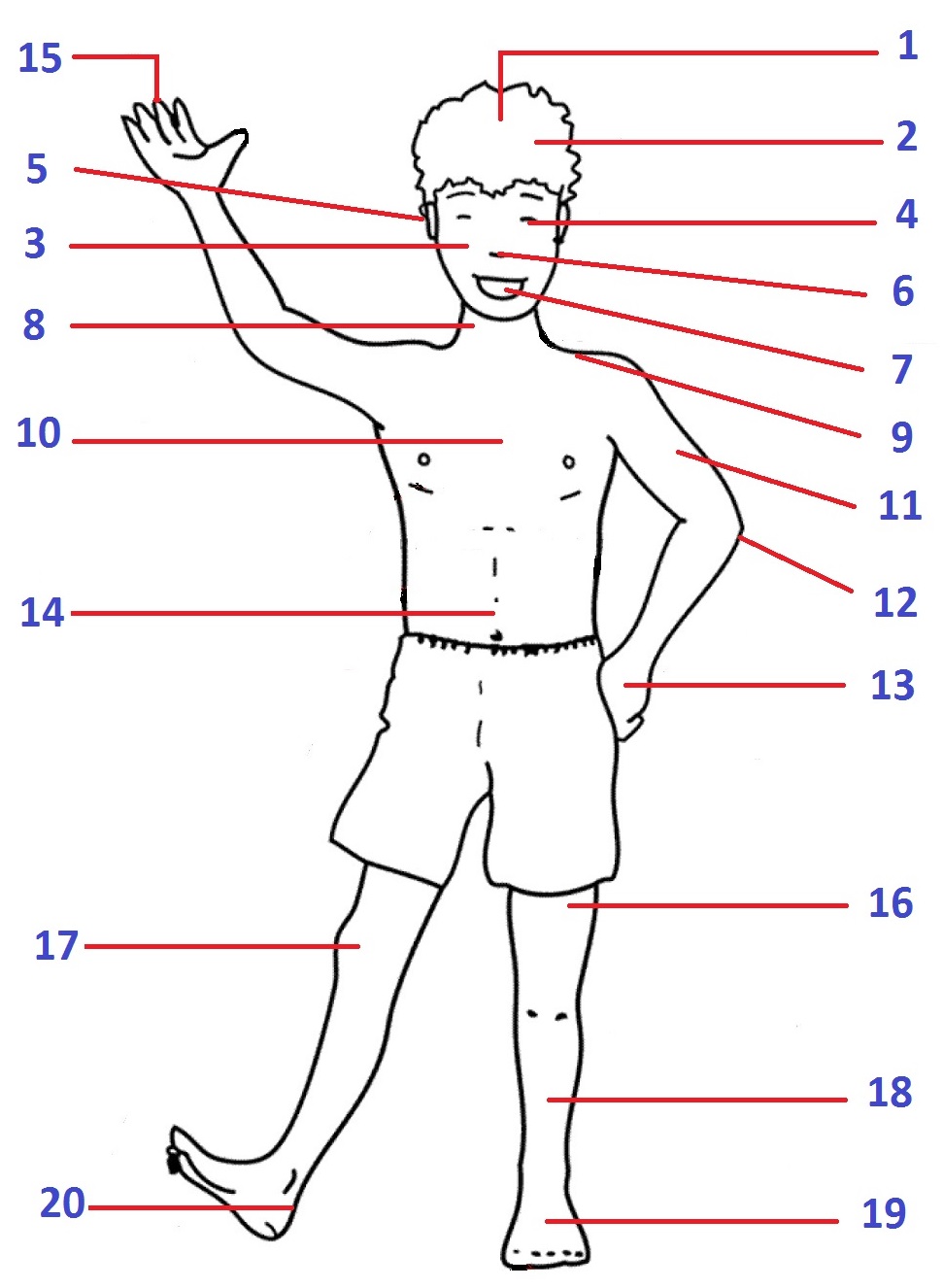| ܓܘܫܡܐ |
| Gušmo | |
| U gušmo du nošo rakiwo yo me hadome baroye w gawoye. | The human body consists of internal organs and external parts. |
| Kul hadomo këtle woliṯo frëšto. | Each organ and each part has a specific function. |
| Ah hadome baroye w gawoye komkamli ḥḏoḏe w koṭorën u gušmo cowad. | The external parts and internal organs complete each other in order for the body to work. |
| Ḥa mah hadomani d howe kayiwo, u gušmo lo koyoraw xud kolozam. | If one of these organs or parts is malfunctioning, the body does not develop as it should. |
| Harke laltaḥ koḥozitu gušmo dë zcuro. | Here you see the body of a child. |
| Ucdo gëd ḥozina ayna ne ah hadome baroye du gušmo. | Now we will see which are the external parts of the body. |

| 1. rišo | ܪܝܫܐ |
| 2. sacro | ܣܰܥܪܐ |
| 3. foṯo | ܦܳܬ݂ܐ |
| 4. cayno / cayne, caynoṯe | ܥܰܝܢܐ؛ ܥܰܝܢܶܐ، ܥܰܝܢܳܬ݂ܶܐ |
| 5. aḏno / aḏne, aḏnoṯe | ܐܰܕ݂ܢܐ؛ ܐܰܕ݂ܢܶܐ، ܐܰܕ݂ܢܳܬ݂ܶܐ |
| 4. nḥiro | ܢܚܝܪܐ |
| 7. femo | ܦܶܡܐ |
| 8. qḏolo | ܩܕ݂ܳܠܐ |
| 9. katfo / katfoṯe | ܟܰܬܦܐ؛ ܟܰܬܦܳܬ݂ܶܐ |
| 10. ṣadro | ܨܰܕܪܐ |
| 11. druco / drucone | ܕܪܘܥܐ؛ ܕܪܘܥܳܢܶܐ |
| 12. caksuno | ܥܰܟܣܘܢܐ |
| 13. iḏo / iḏe, iḏoṯe | ܐܝܕ݂ܐ؛ ܐܝܕ݂ܶܐ، ܐܝܕ݂ܳܬ݂ܶܐ |
| 14. gawo | ܓܰܘܐ |
| 15. ṣawco / ṣawcoṯe | ܨܰܘܥܐ؛ ܨܰܘܥܳܬ݂ܶܐ |
| 16. caṭmo / caṭmoṯe | ܥܰܛܡܐ؛ ܥܰܛܡܳܬ݂ܶܐ |
| 17. barko / barkoṯe | ܒܰܪܟܐ؛ ܒܰܪܟܳܬ݂ܶܐ |
| 18. saqo / saqe | ܣܰܩܐ؛ ܣܰܩܶܐ |
| 19. raġlo / raġle, raġloṯe | ܪܰܓ݂ܠܐ؛ ܪܰܓ݂ܠܶܐ، ܪܰܓ݂ܠܳܬ݂ܶܐ |
| 20. carquwo | ܥܰܪܩܘܘܐ |
| ܐܘ ܓܘܫܡܐ ܡܶܐ ܠܰܪܘܰܠ |
| U gušmo me larwal | Outside Human Body Parts |
| U gušmo du nošo rakiwo yo me basro, garme, galdo, wariḏe w admo. | The human body consists of flesh, bones, skin, muscles and blood. |
| U gušmo komifalaġ l arbco falqe rišoye: rišo, gawo, drucone w raġle. | The body can be divided into four main parts: head, abdomen, arms and legs. |
| Hani cam ḥḏoḏe komkamli i skale du gušmo. | Together, these form the skeleton of the body. |
| I skale du nošo mag garme rakuto yo. Dlo mena layt ḥaye, miḏe d hiya kobo ḥaylo law wariḏe. | The human skeleton is built from bones. Without it there is no life because it supports the muscles. |
| Ag garme konëṭri ah hadome gawoye (organe) du gušmo dlo mitakiwi inaqla d ḥa qoyaṯ b dukṯo. | The bones protect the internal organs of the body so that they will not be hurt if one falls down somewhere. |
| U galdo šëkël d čaket yo cal u gušmo. Konoṭar u gušmo mak kewe. | The skin functions as a jacket of the body. It protects the body against diseases. |
| Lawġël du rišo kit muḥo. | Inside the head is the brain. |
| U muḥo komdabar u gušmo kule. Bu rišo me larwal koḥozina tarte cayne, tarte aḏne, nḥiro w femo. | The brain controls the whole body. In the head, from the outside, we can see two eyes, two ears, a nose and a mouth. |
| Bëṯër koṯën an iḏe w ar raġle. | Then there are the hands and the feet. |
| U nošo këtle ḥamšo rëġše: ḥzoyo bac cayne, šmoco ban aḏne, nqoḥo bu nḥiro, gyošo ban iḏe w ṭcomo bu lišono. | A human being has five senses: sight with the eyes, hearing with the ears, smell with the nose, touch with the hands and taste with the tongue. |
| Lašan du gušmo cowad ṭawwo kolozam d howina le ġalabe moro, bu muklo, w bu štoyo, w bu lwošo. | In order for the body to function well, we will have to take care of it very well, with food, with water and with clothing. |
